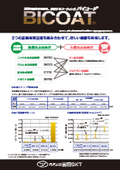[Case Study on Molding Process] Reducing the Use of Release Agents in Molding Dies - Sample Provided
Significantly reduces the sticking of molded materials to the mold surface! Reduces the amount of release agent used, improving the production environment.
We would like to introduce a case where issues arising from the use of release agents in molding with materials that tend to stick were improved through surface treatment. ■ What we wanted to achieve in the molding process - A large amount of release agent was used because the molded rubber material stuck to the mold and could not be removed. We wanted to address the impact of release agent spraying on human health and the deterioration of the environment! ■ Background for selecting surface treatment - Since mass-produced items require several hours for a single molding, we wanted to reduce the effort of reprocessing surface treatments due to the large number of molds. - We wanted to avoid contamination of products due to wear or peeling of the surface treatment. - We also wanted to maintain the dimensional accuracy of the molds. ■ Effects achieved through surface treatment - We adopted a surface treatment that maintains dimensional accuracy and is resistant to peeling and wear. - By using it in conjunction with release agents, we successfully extended the lifespan of the surface treatment and reduced the amount of release agent used. ■ Currently, we are offering a trial set and a collection of case studies for improvements in the molding process! The case study collection can be viewed by downloading the PDF. You can apply for the sample book through the related links.
basic information
■Surface treatment that combines excellent release properties with dimensional accuracy and wear resistance Bicoat, which achieves both "toughness" and "non-stickiness" on the coated surface. Bicoat is a composite organic coating system that combines inorganic materials with high hardness, such as metals, ceramics, and chemical conversion coatings, with organic materials that excel in lubricity and release properties, such as fluoropolymer, siloxane-based resins, and super engineering plastics. For example, it can be safely used in molds that require micron-level dimensional accuracy, providing reliable release properties. *Bicoat® is an abbreviation for bicomponent coating (two types of surface treatment). For more details, please download the PDF or contact us.
Price range
Delivery Time
Model number/Brand name
BICOAT
Applications/Examples of results
【Applications】 ■ Rubber injection molding molds ■ Molds requiring dimensional accuracy for release ■ Parts requiring wear resistance and slip ■ Parts requiring wear resistance and non-stick properties ■ Release of adhesives and sticky materials *For more details, please contact us.
Related Videos
catalog(4)
Download All Catalogs
Recommended products
Distributors
To maximize the performance of manufacturing equipment and machine parts, Yoshida SKT derives the "optimal solution" tailored to our customers from hundreds of surface treatment technologies. - Decreased productivity due to adhesive troubles - Instability in product quality due to friction - Early deterioration of equipment due to corrosion We respond to these challenges in the manufacturing field with our extensive track record and reliable technical expertise. In 1963, we began fluoropolymer processing. In 1968, we signed a licensing agreement with DuPont (now Chemours), supporting manufacturing innovations for over 2,000 customers across various industries, from automotive to medical and aerospace. Furthermore, in 2024, we are focusing on the development of next-generation products, such as PFAS-free coatings, contributing to the advancement of sustainable manufacturing. With a three-base system in Nagoya, Tokyo, and Yamaguchi, we flexibly respond to both mass production and custom orders. Our consistent quality management system ensures that we deliver reliable quality. For solving challenges in the manufacturing field, trust the surface treatment experts at Yoshida SKT.










































